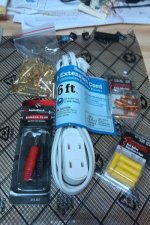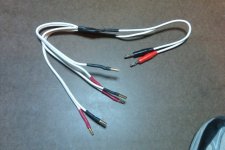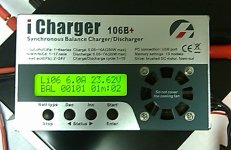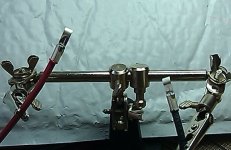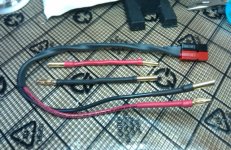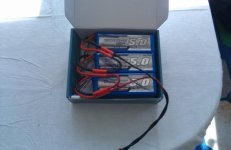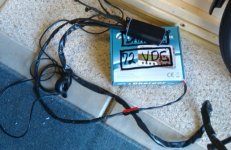Hobbit said:
That looks like a piece of cake to do.... is there soldering involved or are the wires/connectors just crimped/mashed together?
Hi Hobbit - in this case, I soldered the 3-to-1 joint covered by the black shrink wrap together, THEN covered it with a home wiring crimp connector. I crimped the connector onto the joint then melted solder into the crimped connector to improve the joint's physical strength and conductivity. (it will suck right into the connector as it melts. That feature is called "wicking", as opposed to "wicked good", which this is. 8) )
Below, see a photo of the joint immediately after soldering and just before crimping and heat shrink. (The other triple-joint is not yet mated to it's feeder wire, that's the one sticking up.) The three branches were twisted and soldered first, then soldered to the feeder branch. What you see there is a completed, soldered joint about to be covered with the crimp device, then the heat shrink will be slid down the wire to cover the joint and heated to shrink onto the joint.
Notice the low-cost "Third Hand" device behind my hand - the stand with alligator clips. (one of the alligator clips is visible next to my pinky finger) Those things are an invaluable tool when it comes to making joints like this, they hold everything together and you can concentrate on the work instead of having to hold everything through some jury-rigged setup.
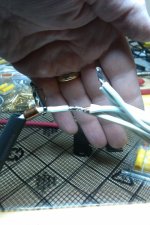
The crimp connectors I used were too big, but they are what I had that would fit over the wire and insulation and wait there so I could crimp. If I were doing it over, I'd choose a smaller "butt crimp connector". (I kid you not, that's it's real name, because the wires "butt" together inside the crimp.)
You can crimp wires together quickly using a butt connector and a cheap crimp tool. Butt connectors are color coded blue, red and yellow, and the crimpers have spots on the jaws marked with blue, red and yellow dots for the right crimp positions. They OK and easy to use, but most hobbyists will add solder inside the device after crimping - the solder will wick right into the crimped connector to protect the joint from oxidization, physically strengthen it and guarantee a good, low-resistance connection.
There's nothing wrong with a properly formed butt crimp, they are used in automotive and aircraft applications all the time. The crimp device and the crimp pliers are specified to match the application and the crimp is filled with a nonconductive paste that blocks air from the joint and arrests oxidization.
But for the cables we're making, I prefer to fill the crimp with melted solder instead to ensure high current capability and good strength. I never crimp and solder without applying shrink wrap afterward, to protect the joint and prevent too much flexing of the wire right past the solder joint. You can use the paint-on rubber insulation (like is used to coat tool handles but you would have to wait for it to cure, taking a long time) or you can use that wrap-on tape that bonds to itself. I stock heat shrink for this in proper sizes to match the joint and the cable. Soldering irons, solder, heat shrink and the third hand tool are available for very low cost at a
Harbor Freight tool store. (no connection, I'm just a customer). If you do go to Harbor Freight to get these items, buy a higher-wattage soldering iron or pistol, something 50 watts or better. I used a 100/140W soldering "gun" for this work and had no trouble at all - my tool of choice for soldering cables and connectors.
Very Important: Look carefully at the ends of the cable. This cable is polarized throughout, but you have to make it that way. The insulation on one wire is smooth, and on the other is ribbed. I made the ribbed side positive and the smooth side negative. The first thing I did to establish polarity was to solder the banana plugs on - red to ribbed and black to smooth. Then I soldered the positive banana plug to the ribbed side and covered those joints with red heat shrink. I soldered the negative 4mm bullet "jack" to the negative side and covered that in black heat shrink. You cannot let these plugs touch each other when hooking things up. When I use it, I'll plug all the positive plugs into the batteries first, then the negative plugs, then carefully plug the two banana plugs into the already-powered-on charger. 


